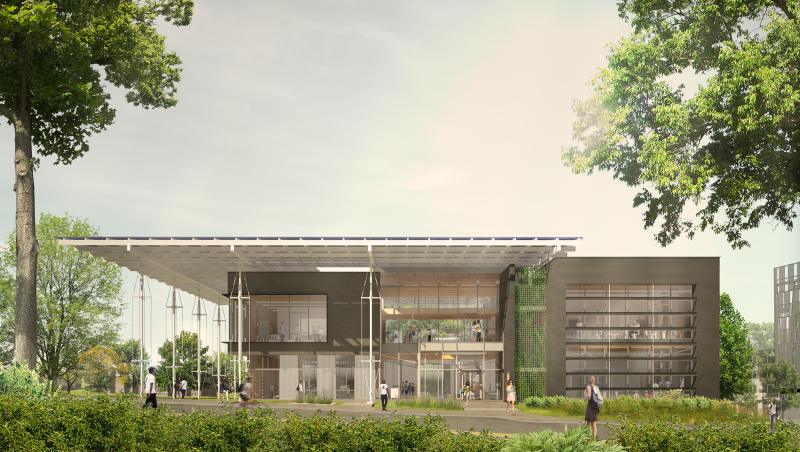A Living Building Project Journey, Part-6
Net Positive Energy

The project is being designed to be “net positive,” producing at least 105% of the energy it consumes, on an annual basis. Successful Living Building Challenge certification requires achievement of the Net Positive Energy Imperative. To accomplish this most cost effectively, design strategies are prioritized with attention first to climate-appropriate passive design, then energy conservation measures (ECMs) and finally onsite renewable energy. ECMs typically yield operational energy savings, but for projects reliant on onsite renewable energy, ECMs serve to reduce the size of the renewable energy system required, thereby offering first cost savings.
FIGURE 1. A Schematic Section along E-W axis looking at North (Image courtesy: The Miller Hull Partnership)
The amount of intentionality and rigor required in the energy design of a project with a fixed energy budget is remarkable. Decisions about operations have become as important as decisions about design. Factors such as operating hours, thermostat setpoints, plug loads, etc.—items that could otherwise seem trivial—assume enormous importance when the energy budget is constrained and all power must be generated locally. To illustrate this, here are some example energy issues that will continue to be analyzed:
- Can the upper limit of relative humidity (RH%) in some student center spaces be raised?
- Can the project accommodate the energy demands of a programmatically desirable coffee cart?
- How much energy will onsite water treatment strategies, necessary to meet Net Positive Water, require?
- How many laptops, tablets and phones are likely to be charged at convenience outlets on a typical day?
Maximized year-round harvesting of daylighting, natural ventilation during shoulder seasons, and control of unwanted solar gains, including architectural shading devices as well as strategically placed trees, are a few of the core passive design strategies.
FIGURE 2. An example daylight simulation showing 75 footcandles of daylight on the atrium floor at noon on September 21. (Looking south)
Some of the ECMs under consideration include:
- Triple pane glazing to improve both energy performance and occupant comfort
- Exterior operable venetian shades for solar control and daylight optimization
- Expanded thermal comfort ranges utilizing ASHRAE 55 with an expanded range in some spaces, aided by ceiling fans
- A high efficiency geothermal HVAC system
Design alternatives are evaluated iteratively using energy and heating/cooling loads models managed by PAE Consulting Engineers, the project’s MEP designers, and through daylighting analysis performed by Lord Aeck Sargent and The Miller Hull Partnership.
The project’s current predicted Energy Use Intensity (pEUI) is presently around 28 kBtu/sf/year. About 17,000 square feet of solar photovoltaic (PV) panels will be required to meet the predicted demand. The PV array will multitask by producing energy, collect rainwater and providing shade for the south and west facades.
A net positive energy building requires significant planning and design team coordination to produce a structure capable of meeting the certification requirements. While occupant behavior is always a challenging variable to pin down for predictive modeling, Georgia Tech is currently studying other Living Building Challenge models to better understand how occupant behavior will affect the design, operation and maintenance of the Living Building at Georgia Tech.
FIGURE 3. pEUI being evaluated for different possible ECMs (Image courtesy: PAE Consulting Engineers)
Funded through a private grant from The Kendeda Fund, the Living Building at Georgia Tech is expected to become a Living Building Challenge 3.1 certified facility – the built environment's most rigorous and ambitious performance standard. The project’s design and build partners include architects Lord Aeck Sargent in collaboration with The Miller Hull Partnership, construction manager Skanska and design team consultants: Newcomb & Boyd, PAE Consulting Engineers, Uzun + Case, Biohabitats, Andropogon and Long Engineering.





#1. Posted by David Apple on July 01, 2017
Thank you for the descriptive articles about the living building. What Georgia Tech function will be house in this interesting facility?
#2. Posted by Ramana Koti on July 03, 2017
David, thanks for your question. It will be classrooms, an auditorium, and student collaboration spaces. We don’t yet know which department or group specifically.